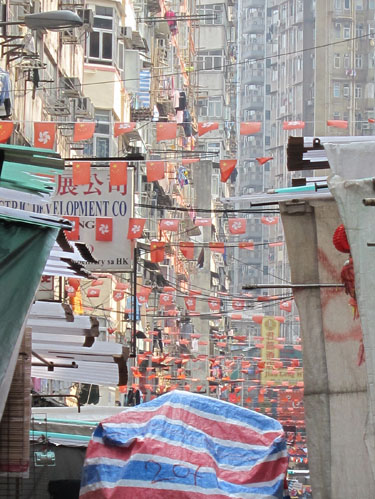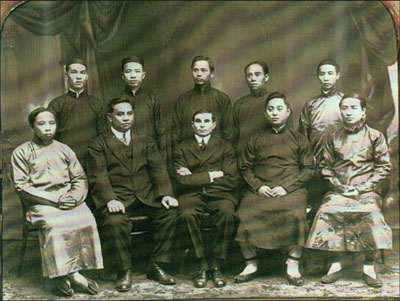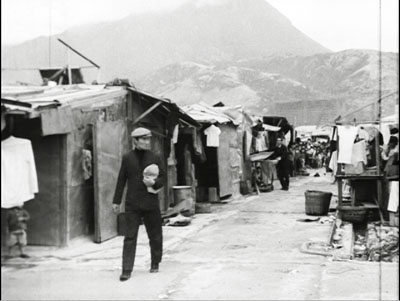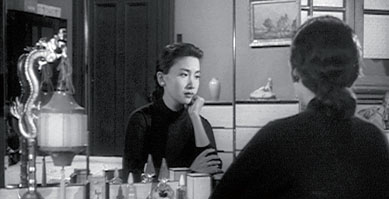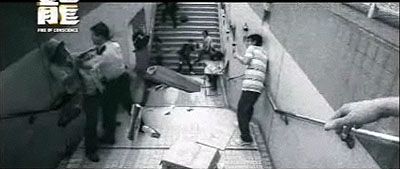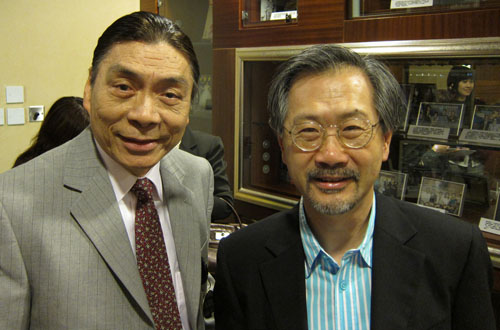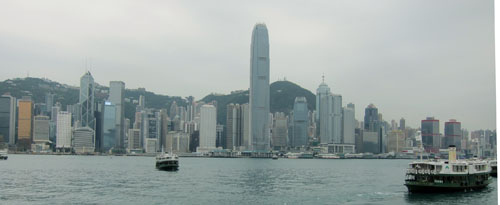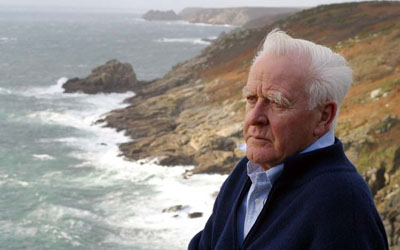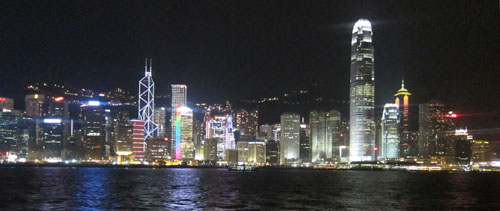Archive for the 'Festivals' Category
Hopscotching through history
Temple Street, Hong Kong.
DB here:
Thanks to the Film Festival and screenings at the Film Archive, I’ve skipped gratefully through nearly a hundred years of local film history.
The Roast Duck legend, cooked at last?
First things, or rather first films, first. Last year local authorities declared 2009 to be the centenary of Hong Kong cinema. The long-standing claim (repeated in my Planet Hong Kong) was that To Steal a Roast Duck, aka The Trip of the Roast Duck, was made in 1909 and was the first locally produced fiction film. The controversy arose because the claim was based on later recollections of filmmakers. No fiction films from that era survived. We had no contemporary evidence that the Roast Duck was made in that year or that it was the first anything. Perhaps it wasn’t even made at all? In a blog entry last year, I summed up the arguments.
Now, thanks to the persistence of Frank Bren and Law Kar, we can come to more reliable conclusions. At a conference in December, scholars from around the world gathered at the Hong Kong Film Archive to discuss early Chinese cinema. One of the results was further revelations about the territory’s first film.
We know that at some point the Ukrainian-American entrepreneur Benjamin Brodsky came to Hong Kong and set up a film unit. (The picture above shows him surrounded by nine Chinese co-directors of the company he founded in November 1914.) An earlier Brodsky company made Roast Duck, among other films. But when?
At the conference Law Kar announced the discovery of a 1914 Moving Picture World interview with Roland Van Velzer, a photographer recruited from New York by Brodsky. During his stay in what he called “that queer land” of Hong Kong, Van Velzer shot four films in 1914.
We did a first native drama, entitled “The Defamation of Choung Chow.” With my experience and guidance the picture turned out well and when shown in public proved to be a wonderful drawing card. . . . The reason of its great popularity was because it was a Chinese piece entirely. . . . We made three other subjects during my stay there. These were: “The Haunted Pot,” The Sanpan Man’s Dream” and “The Trip of the Roast Duck,” the latter a rough “chase” picture. All of these pictures had phenomenal runs at the native theaters.
According to Van Velzer, then, the first film, made and shown in 1914, was what is now known as Chuang Tzi Tests His Wife. Roast Duck was evidently the fourth film made by the team that year.
Brodsky is significant not merely because he supported talent in producing the colony’s first fictional films. He also made long documentaries about China and Japan that played in the US. He seems to have been a colorful guy. In his barnstorming circus days, he once purged a lion with castor oil. Full details are here in an article by Bren and Kar. In the meantime, we can look forward to a more plausible centenary of Hong Kong film in 2014.
Social conscience, modern stylings
The Story of a Discharged Prisoner.
Hop ahead to the 1960s. Although the local language of Hong Kong is Cantonese, movies in Mandarin rule the market, with Shaw Brothers providing gaudily colored costume pictures, musicals, romantic dramas and comedies, and of course rather violent swordplay exercises. By contrast films made by Cantonese companies under tiny budgets look threadbare. Yet a few filmmakers tried to make Cantonese cinema more vigorous and innovative, and the most influential was Patrick Lung Kong.
Lung Kong was born in 1935, and by the time he was thirty he had performed in virtually every production role, from screenwriting and producing to publicity and distribution. Well-known as an actor since 1958, he graduated to directing in1966 with Prince of Broadcasters. His second film, The Story of a Discharged Prisoner (1967) was a landmark in local cinema, expressing sympathy for an ex-convict who tries to avoid being pulled back into crime. Lung Kong goes on to make many of the socially critical films of the period: Teddy Girls (1969), Hiroshima 28 (1974), and Mitra (1976). He ceased directing in 1981 but continued to work as an actor and distributor. He now lives in New York City, but he came back for the retrospective that the Film Archive has mounted.
I had seen some Lung Kong films in earlier visits to Hong Kong, but the retrospective will allow us to assess his career as a whole. Virtually none of his films are available on DVD, and none, as far as I know, with English subtitles. Particularly important, apart from the works I’ve mentioned, are his heavily censored film about a plague striking Hong Kong, Yesterday Today Tomorrow (1970) and the bitter domestic drama Pei Shih (1972).
When he started in the industry, he says, “I ran into these acquaintances who taunted me by saying how I was trying my hand at making Cantonese chaan pin [shabby films]. That was very insulting to the film profession in general…so I promised myself to go in and change things when the opportunity arose.” For him, change meant both modernizing Cantonese film technique and tackling social problems.
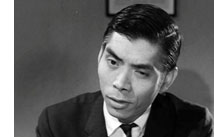 Lung Kong’s cinema, all agree, has a strong moralizing bent. He focuses on social problems—juvenile delinquency, nuclear war, prostitution, the exploitation of women in marriage. The films mix sensationalism, partly as audience bait, and social criticism. The Story of a Discharged Prisoner, reimagined by Tsui Hark and John Woo as A Better Tomorrow (1986), is at once a gangster tale and a harsh comment on the poverty that drives men to crime. Lung himself, armed with calisthenic eyebrows, plays the police officer hounding the protagonist. The Prince of Broadcasters begins as a pointed critique of popular culture, where schoolgirls fasten obsessively on a playboy radio personality. The film devolves into a more traditional thwarted-lovers plot when the protagonist reforms through his (mostly) chaste relationship with a wealthy girl.
Lung Kong’s cinema, all agree, has a strong moralizing bent. He focuses on social problems—juvenile delinquency, nuclear war, prostitution, the exploitation of women in marriage. The films mix sensationalism, partly as audience bait, and social criticism. The Story of a Discharged Prisoner, reimagined by Tsui Hark and John Woo as A Better Tomorrow (1986), is at once a gangster tale and a harsh comment on the poverty that drives men to crime. Lung himself, armed with calisthenic eyebrows, plays the police officer hounding the protagonist. The Prince of Broadcasters begins as a pointed critique of popular culture, where schoolgirls fasten obsessively on a playboy radio personality. The film devolves into a more traditional thwarted-lovers plot when the protagonist reforms through his (mostly) chaste relationship with a wealthy girl.
Lung’s film style is self-consciously 1960s modern, with zooms, calculated compositions, and handheld passages. He cuts fast, avoids dissolves, and offers fairly complex traveling shots. Looking at the cheap sets and listening to the awkward sound (including snippets of classical music and The Great Escape grabbed from LPs), one becomes aware of what a Cantonese director of the day was up against. So if the technique seems at times forced, you can at least admire Lung’s attempt to give his films a contemporary gloss.
The films were of crucial importance for local culture of the 1960s and have had continuing influence on younger directors. A very informative book of essays and interviews, produced to the usual handsome standards of the Film Archive, is in Chinese but includes a disk with a digital pdf of English translations. Two of the texts can be found here.
Jean Christophe in Macau
Another hop. I know nothing about Louis Fei, except that he was the brother of Fei Mu, whom I’ll be talking about in an upcoming entry. Romance in the Boudoir (1960) recasts the core situation of Fei Mu’s masterpiece Spring in a Small Town (1948). The situation, drawn from Romain Rolland’s novel Jean Christophe, is simple: A woman in a loveless marriage is visited by her former lover. In this version, her husband is a miserly doctor who wants the lover, Qin, to help him get a hospital post. Qin’s presence in the household rekindles the old romance and the couple hover on the edge of adultery.
Romance in the Boudoir is a bold piece of work. It opens with a prologue showing husband and wife trudging through Macau, utterly distant from each other. On the soundtrack we hear a woman singing about marriage as a prison. When Qin arrives, a parallel sequence traces him from the harbor to the household as a male vocalist sings of his weariness and broken heart. These melodic soliloquies will be evoked later in the film, when Qin and Suxuan stretch out by the fireplace and start to sing as the camera circles them.
Louis Fei makes maximal use of the house set, letting the vast staircase dominate the action on both floors. Repeated setups from the top of the stairs show the bannister cutting diagonally into the frame, pointing like an arrow to the climactic moment at the front door in the distance. Over everything hovers erotic tension, lasting several minutes during one scene when the former lovers tentatively touch one another before recoiling and then drawing toward one another again. If the doctor is somewhat caricatural, the portrayals of the wife and lover show a great subtlety, and the use of props, notably a glass of milk, is nicely modulated. This film shows how comparative large budgets enabled the Mandarin-language companies to make films of a high production standard, both in script and execution.
Dragons on fire
Now jump to 2010. Dante Lam is the hot new action director on the local scene, after the success of Beast Stalker (2008) and The Sniper (2009). Actually, like most overnight successes, he’s been at it awhile. He made an admirer of me with Jiang Hu: The Triad Zone (2000), which has one of the most graceful passages of graphic cutting (involving a red umbrella) that I’ve seen in recent Hong Kong film.
He’s back with the first big action film of the season, tagged with the barely adequate English title Fire of Conscience. The action scenes are better than the plot, which is better than the eternal impassivity of Leon Lai, a pictorial cipher in nearly every role he assumes. Still, you have to reckon with a film that includes not only a thrilling car chase, a truly scary gunfight in a restaurant, and grenades tossed around pretty casually but also a pregnant woman locked in a car slowly filling with carbon monoxide. The topper comes in the very last few shots, which provide as gruesome a flashback image as I’ve seen in quite some time and justifies the key line, “Save for revenge, what else is there?”
Visually, Fire of Conscience never surpasses the bravado of the black-and-white CGI opening, during which the camera coasts through a snapshot of action and lets clues float and scatter around the frozen characters. (It’s admittedly gimmicky, but more hypnotic than the comparable Watchmen opening.) Still, it’s exciting genre fare. What hath Ben Brodsky wrought?
Photo of Brodsky and colleagues by courtesy of Mr. Ronald Borden. The interview with R. F. Van Velzer was published in Hugh Hoffman, “Film Conditions in China,” Moving Picture World (25 July 1914), 577. Thanks to Frank Bren and Law Kar for this information, and to Tony Slide for calling attention to the article. The quotation from Lung Kong is from Clarence Tsui, “Scenes of the Crime,” South China Morning Post (22 March 2010), C1.
Patrick Lung Kong, with Sam Ho of the Hong Kong Film Archive.
The spy who came in from the typhoon
Every year I buy a used paperback of John le Carré’s The Honourable Schoolboy (1977) and take it to Hong Kong with me, to be left for someone else when I pack up to leave. One year I left a copy, then returned the following year to the same hotel. The desk clerk remembered my name and ran to the back room, where last year’s copy had been carefully retained.
During my first trip in spring of 1995, I found The Honourable Schoolboy remaindered in a Silvercord bookshop that has long since vanished. Reading the novel while I encountered HK for the first time was an exhilarating experience because, of course, the story is set there. Le Carré aficionados know that it’s the second in the Quest for Karla trilogy launched by Tinker, Tailor, Soldier, Spy and completed by Smiley’s People. In this middle installment, we see how the mole who infiltrated the highest reaches of British intelligence wrecked the spy setup in the Crown Colony. A youngish agent, Jerry Westerby, is sent there to pursue the possibility that a member of Hong Kong’s business elite might be representing Soviet interests. Eventually, since this is Hong Kong, opium and the People’s Republic push their way into the picture.
The particular enjoyment I get from this novel during my visits owes a lot to its evocation of a city in the seventies that remains recognizable today.
Star Heights was the newest and tallest apartment block in the Midlevels, built on the round, and by night jammed like a huge lighted pencil into the soft darkness of the Peak. A winding causeway led to it, but the only pavement was a line of curbstone six inches wide between the causeway and the cliff. At Star Heights, pedestrians were in bad taste.
Yet the pleasures go far beyond acute observation of local detail. Everything that makes le Carré a splendid storyteller appears at full stretch in The Honourable Schoolboy.
The novel shows how intelligence missions, no matter how carefully planned, spin out of control because of human frailties, administrative rivalries, budget cuts, and political expediency. Sound familiar in the America of today? Like its mates in the Karla trilogy, the book begins on the periphery of the action, filling in secondary characters before building patiently towards a widely-ramifying plot. Le Carré manipulates point of view in a way that few novelists can manage, giving us a sense of circles of power made up of unnamed observers commenting on things they don’t understand. Here are the opening sentences of the first three paragraphs.
Afterward, in the dusty little corners where London’s secret servants drink together, there was argument about where the Dolphin case history should really begin. One crowd, led by a blimpish fellow in charge of microphone transcription, went so far as to claim that the fitting date was some sixty years ago. . . .
To less-flowery minds, the true genesis was Haydon’s unmasking by George Smiley and Smiley’s consequent appointment as caretaker chief of the betrayed service, which occurred in the late November of 1973.
One scholarly soul, a researcher of some sort—in the jargon, a “burrower”—even insisted, in his cups, upon January 26, 1841, as the natural date, when a certain Captain Elliott of the Royal Navy took a landing party to a fog-laden rock called Hong Kong at the mouth of the Pearl River and a few days later proclaimed it a British colony.
Our unidentified chronicler has the omniscience of an urbane insider. This is institutional memory as rumor, half-baked opinion, and shreds of fact, flavored with a touch of sarcasm. At the same time, this first page is a call to adventure. You can’t miss the rumble of kettledrums and thunder in the distance. This story will unfold in a spacious, even leisurely, manner, but will be no less suspenseful for that.
A page along we read:
The debate continues wherever old comrades meet, though the name of Jerry Westerby, understandably, is seldom mentioned. Occasionally, it is true, somebody does, out of foolhardiness or sentiment or plain forgetfulness, dredge it up, and there is atmosphere for a moment; but it passes. Only the other day. . . .
The worrisome chord is struck in a single word: understandably: At this point we understand no such thing, but five hundred pages later we will. Only then will this passage, reread, deliver its full charge of pathos.
Our chronicler’s tradecraft is impeccable. Most narratives consist of taking someone from one place to another and having him or her talk to somebody else. This poses several problems: (a) creating a vivid scene of character interchange; (b) using that interchange to summon up past events with clarity; and (c) pushing the story forward by having us understand what is gleaned from the conversation. Le Carré’s masterwork in this regard is probably Smiley’s People, which is almost Jamesian in suggesting that nearly all the important action is over, and what matters is how it has changed people’s lives. But The Honourable Schoolboy solves the problem no less deftly. Today’s spy novel would be unlikely to devote twenty pages to the questioning of the slightly gaga Reverend Hibbert, served tea by his scowling daughter. Yet it is a whole short story in itself.
Like other le Carré novels of the period, The Honourable Schoolboy displays an almost Dickensian relish in human variety. Every character is a little magnified, endowed not only with memorable tags, speeches, and bits of behavior but a pervasive attitude toward life that shifts our perspective on the main action. It’s as if the stolidity and self-containment of spymaster George Smiley calls forth extravagance in the portrayal of nearly all his staff. Connie Sachs, the bubbling, arthritic Soviet expert who carries her dog with her everywhere; de Salis, the Chinese specialist who tugs his hair and writhes as he reports; Fawn, Smiley’s devoted little bodyguard, who will grin while he breaks a man’s arms—the characters have something that most of today’s novelists, committed to the mundane, fail to give us: eccentric vitality.
The characters’ colliding attitudes emerge most starkly in a situation in which le Carré rules supreme. That is the administrative meeting. No writer I know is better at tracing the ripples of jealousy, showoffishness, toadying, and side-switching set loose when rather colorless men (it is always men) sit around a table and struggle for bureaucratic power. Le Carré is especially good on American arrogance.
One of the quiet men used the work name Murphy. Murphy was so fair he was nearly albino. Taking a folder from the rosewood table, Murphy began reading from it aloud with great respect in his voice. He held each page singly between his clean fingers.
Lest it be thought from these books, and from le Carré’s outrage against the Iraq war, that he is a reflexive anti-American, it should be said that he is no less severe with the Brits. One of his most scathing nonfiction pieces is his introduction to The Philby Conspiracy, where he denounces English snobbery and complacency for facilitating the real-life counterspying that formed the basis of his trilogy. Throughout his work, le Carré asks whether decency and kindness can survive the cynicism and compromises of a life built on deceit. Whether anyone, schoolboy or not, can retain honor in the Great Game is the central question of his Hong Kong novel.
Le Carré manages to show the bureaucrats’ tabletop swordplay as at once petty, springing from vanity and professional spite, and momentous. The world, or at least some big part of it, really is at stake. By the end of The Honourable Schoolboy, Westerby is at the end of his rope and he contemplates the betrayals and innocent deaths at which he has connived. Through his bitter disillusionment, we see an apocalypse.
As he gazed through the rear window of the car, it seemed to him that the very world that he was moving through had also been abandoned. The street markets were deserted, the pavements, even the doorways. Above them the Peak loomed fruitfully, its crocodile spine daubed by a ragged moon.
It’s the Colony’s last day, he decided: Peking has made its proverbial telephone call. “Get out, party over.” The last hotel was closing; he saw the empty Rolls-Royces lying like scrap around the harbour, and the last blue-rinse round-eye matron, laden with her tax-free furs and jewellery, tottering up the gangway of the last cruise ship; the last China-watcher frantically feeding his last miscalculations into the shredder; the looted shops, the empty city waiting like a carcass for the hordes. For a moment it was all one vanishing world; here, Phnom Penh, Saigon, London—a world on loan, with the creditors standing at the door and Jerry himself, in some unfathomable way, a part of the debt that was owed.
The end of empire has seldom been evoked so chillingly, and any day now the creditors whom Jerry imagines, moving toward hypermodernization, will be calling for payment.
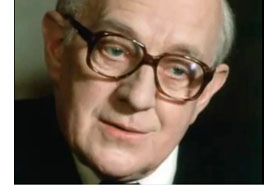 The first and last novels in the trilogy became BBC adaptations, and they’re watchable, largely because of Alec Guinness as Smiley. They were shot in 16mm, largely on location, and the visual drabness fits the atmosphere of the books. (See the opening of Tinker, Tailor here.) It was evidently beyond the BBC’s budget to film The Honourable Schoolboy in Hong Kong, Cambodia, and Thailand, or plausible facsimiles thereof.
The first and last novels in the trilogy became BBC adaptations, and they’re watchable, largely because of Alec Guinness as Smiley. They were shot in 16mm, largely on location, and the visual drabness fits the atmosphere of the books. (See the opening of Tinker, Tailor here.) It was evidently beyond the BBC’s budget to film The Honourable Schoolboy in Hong Kong, Cambodia, and Thailand, or plausible facsimiles thereof.
There is a BBC radio version, but I still hope for a film adaptation some day. The story can stand independently of the trilogy, and with its multiple viewpoints, sympathetic protagonist, geopolitical themes, vivid settings, and side trips to Southeast Asian theatres of war, it could in respectful hands make for a strong feature.
In the meantime, we have the book. Granting my special fondness for its locale, I still think it one of the great novels—not great “genre” novels, but just great novels—of the century just past.
Wrapping up the ROW
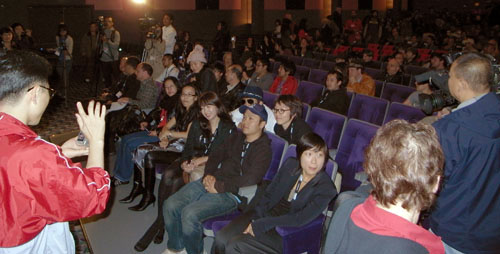
Paparazzi swarm over the nominees for the Dragons and Tigers Award at the Vancouver International Film Festival.
Kristin here:
Some final films from VIFF
So far Central American countries have produced fewer films than their neighbors to the north and south. So I couldn’t pass up The Wind and the Water, the first fiction feature made in Panama. Made by a collective of fifteen young indigenous people from the Kuna Yala archipelego under the leadership of MIT graduate and first-time director Vero Bollow, it’s a tale of threats to the paradisiacal island by developers who want to build a giant hotel there. It also reflects temptations for young people to desert their traditional lives on the islands for the attractions of nearby Panama City.
The contrast between the islands emerges through a simple tale. Machi, a young man from the islands, goes to the city for schooling and finds it grim and threatening. Rosy, a transplanted native who grew up there, aspires to be a model.

She returns to the islands for her grandfather’s funeral. Confronted with crude latrines and fish-head stews, she is initially miserable but gradually falls under the spell of the area’s beauty. Meanwhile her father works for the group planning to move the islands’ population to a new suburb and build their resort.
The plot is based loosely on that population’s vigorous efforts—successful so far—to fend off efforts of outsiders to gain control of the islands. I was reminded while watching it of the many classic documentaries of the 1930s and 1940s, like Song of Ceylon, shot by Americans and Europeans in exotic locales. For decades film scholars deplored the fact that the people who formed the subjects of such films were being portrayed by outsiders. The Wind and the Water, though a fiction film, has a strongly documentary thread running through it, but this time it is the local population making a film about their own situation.
 Bollow (right), who initially left MIT to live in Panama and bring digital technology to indigenous people, wrote the script along with the fifteen team members. She attended Vancouver and answered questions, but members of the team will be traveling with the film to other festivals.
Bollow (right), who initially left MIT to live in Panama and bring digital technology to indigenous people, wrote the script along with the fifteen team members. She attended Vancouver and answered questions, but members of the team will be traveling with the film to other festivals.
In some ways, Ozcan Alper’s debut feature, Autumn, is a classic art-house film. Yusuf, a student radical, is released after ten years in prison because he has a fatal lung disease. He returns to his home. He returns to his rural home in the eastern Turkish mountains and settles in with his widowed mother, keeping his illness secret. He tutors a local boy in math and perhaps falls in love with a melancholy prostitute struggling to support her child.
Many of the scenes consist of the hero lying or sitting in the yard, contemplating the surrounding mountains as autumn slowly changes them. David found the lack of dramatic action and the slow pace of the scenes to be overly familiar conventions of art cinema. No doubt the hero’s goals are de-dramatized, as when he promises a bicycle to the student should he succeed in mother or when very late in the film he decides to help the prostitute. There is one central motif that becomes overly emphatic. When Yusuf first notices the prostitute, she is buying a Russian novel; they simultaneously sit alone watching the same broadcast of Uncle Vanya; eventually she tells Yusuf that he’s like a character out of Russian literature. The film’s tone successfully suggests this comparison without our needing to have it made explicit.

To me, the success of the film arises from the director’s integration of the landscape into the story. The prominence of the rugged landscape and the care with which the story is linked to the fall of leaves and the creeping of snow down the mountainsides lifts this above standard art-house fare. In this case, the fading of the year, beautifully brought into a central role by the cinematography, becomes linked more subtly to the hero’s plight.
Kill Daddy Goodnight, an Austrian film by veteran director Michael Glawogger, starts with a promising premise. The protagonist Ratz hates his father, a cold and critical government minister, and creates a videogame, “Kill Daddy Goodnight,” to wreak a fantasy revenge. Summoned by Mimi, a friend with whom he may or may not be in love, he abruptly flies to New York. She wants him to renovate the basement hideaway of her grandfather, a fugitive Nazi war criminal. Initially revolted, over the course of his work he comes to like the old man. Ratz also manages to find a sleazy internet entrepreneur willing to offer “Kill Daddy Goodnight” on his website, where it becomes an immediate success. Interspersed with this plot are scenes of an unidentified man (below) recording testimony against and visiting his childhood friend, who had worked for the Nazis during the war and killed his father.
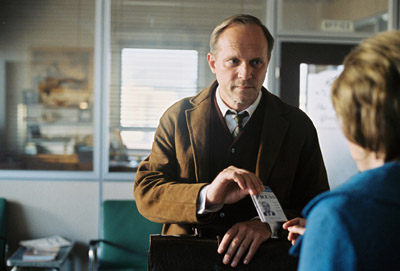
So far, so good. But the film’s already complex plot is overburdened by strong hints of Ratz’s incestuous desire for his sister, a thread that comes to little. Mimi’s motivations are confusing, and it’s hard to sympathize with any of the characters. Perhaps that was the intention, but my sense was that the two intriguing plotlines, which could have fit neatly together, were diffused by distractions and uncertainties.
I didn’t get to many documentaries, but being a lover of Vivaldi’s vocal music, I had to see Argippo Resurrected. It’s the fascinating tale of how Czech conductor and musicologist Ondrej Macek ingeniously tracked down the lost 1730 opera, which had originally been composed for Prague. He then staged the piece in one of the two perfectly preserved court theaters of the era, the Castle Theatre at Cesky Krumlov, two hours outside of Prague, near the Austrian border.
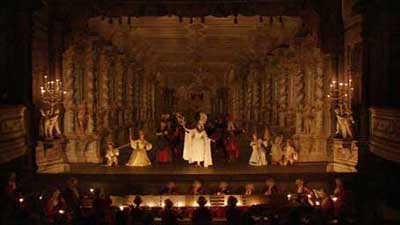
The other is at Drottningholm, outside Stockholm, where in 1999 David and I had the privilege of seeing The Garden, a new opera about Linnaeus. (It was the first premiere at the theater since it was sealed in the 18th century.) The original candles have prudently been replaced by electric replicas of one candlepower each, flickering realistically. The Cesky Krumlov theater still uses real candles to light both the stage and the musicians’ stands. I guess this says something about fire codes in Eastern Europe. I for one would be happy to risk it in order to have a thoroughly authentic experience, especially if a Vivaldi opera was playing.
It’s a complicated story to fit into 62 minutes. Director Dan Krames took a clever and effective approach, starting backwards. He shows the theater first, with its wooden framework, sets, and stage machinery. He then goes on to introduce some of the musicians and singers, in the process explaining the concept of authentic performance style to those who may not be familiar with it. We also get to see some short excerpts from rehearsals, so that we come to know the opera a little. Only then does Krames proceed to the tale of Macek’s search for the original manuscript and his laborious piecing-together of the individual arias. Macek makes an engaging subject, though he is so self-deprecating about his discovery that the film has to include another musicologist to explain just how extraordinary the accomplishment was.
Finally Macek takes us on a tour of Venice, showing the few surviving places associated with Vivaldi, whose life is little documented. Along the way, there are further excerpts from rehearsal for the production shown, featuring a collection of excellent singers. Krames told me that Argippo Resurrected should be released on DVD in about a year. In the meantime, a live recording of Macek’s production is available as a 2-CD set.
Some final photos
Film festivals aren’t just for watching movies, of course. They’re for seeing old friends, meeting new ones, and sharing meals—including the festival’s wonderful hand-made waffles—to talk about what we’ve seen. As usual, David had his camera in hand nearly all the time, as the accompanying images show.
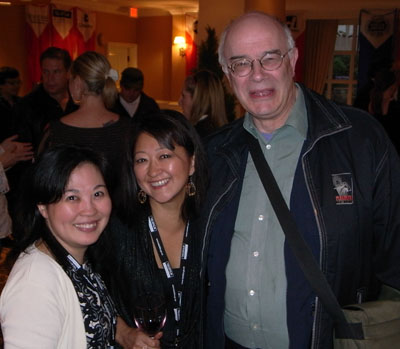
Theresa Ho, Eunhee Cha, and Tony Rayns: Three key players in the Vancouver Festival.
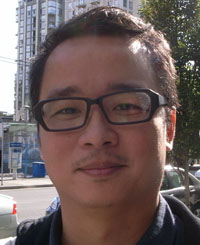
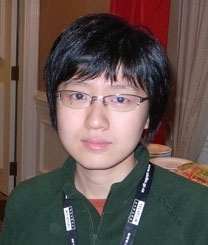
Chris Chong (director of Karaoke) and Liu Jiayin (Oxhide II).


Bob Davis, of American Cinematographer, and Noel Vera, Critic after Dark.

Canadian corner: Lisa Roosen-Runge, Shelly Kraicer, and Peter Rist.

Get your Terimayo, Oroshi, and Okonomi here: Japadog, a Vancouver Institution.
Wantons and wontons
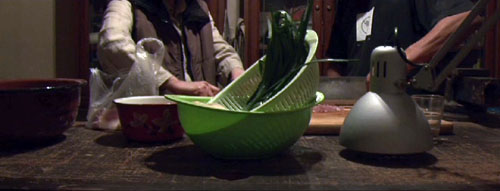
Oxhide II.
DB here, with more from the Vancouver film fest:
Two of the more innovative films I saw evoked film history—one explicitly, the other obliquely. Raya Martin’s Independencia is part of a planned series devoted to the history of the Philippines, told from the bottom up. In this first installment, villagers flee into the jungle to hide from the American “liberation” of their islands. The film centers on a mother and son who, joined by a woman the son finds, create a new family. After years, the son and the woman have a child, but their new life is threatened by the encroachment of the invaders.
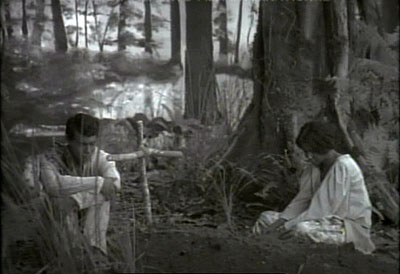
What sets Independencia apart is Martin’s effort to create the look and feel of a 1930s fiction feature. He shot the movie wholly in a studio, and the evidently faked backdrops are counterbalanced by gorgeously controlled lighting effects, and even dashes of color. Since virtually no Filipino films survive from this period, Martin gives us less a pastiche than a possibility, a sort of hypothetical archival film. The fact that the film makes aggressive use of Dolby sound, especially during a tremendous storm sequence, only adds to the sense of history being reimagined for today.
More traditional, at first glance, is Puccini and the Girl, a historical drama by Paolo Benenuti and Paolo Baroni. Facts of the case: In 1909, a maid in Puccini’s Tuscan villa, accused of being his concubine, committed suicide. But an autopsy revealed that she was a virgin.
The film’s reconstruction of what happened behind the scenes, tracing the veins of jealousy and deceit running through the household, relies on recent research into the tragedy.
At the same time, we have an homage to silent cinema. In most scenes we hear no dialogue: actors whisper at a distance from us, or simply conduct themselves without speaking. What words we do hear are recited pro forma (the Mass) or sung (in a waterside tavern, or in nondiegetic accompaniment). There is only one line of conversation, and that is given greater saliency by being a cry from the heart.
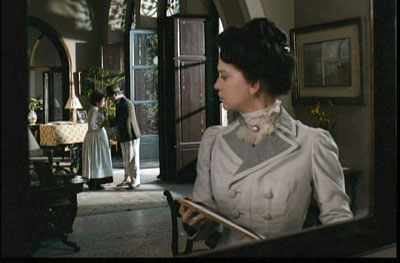
So we’re largely confronted with a silent film, accompanied by music and sound effects. To add to the estranging effect, characters communicate chiefly through letters and telegrams—exactly as in the films of the period. We hear the letters’ text read aloud, but the sense of stately compositions propelled by written commentary, distinctive features of 1910s cinema, remains. An unwitting homage, perhaps, but one that pleased this fan of classic tableau cinema.
Independencia was part of the Dragons and Tigers thread, one of the hallmarks of the Vancouver event. Year after year it gives an unequaled view of current Asian cinema. This year’s program, assembled by Tony Rayns and Shelly Kraicer, was at least as fine as ever. Eight films compete for the $10,000 prize given to first or second features. The winning film, Eighteen by Jang Kun-jae, centered on the familiar situation of teenage lovers separated by parents and school pressures. I didn’t see all the competitors, but my own favorite was Chris Chong’s Karaoke, a Malaysian story of a young man coming to terms with his mother’s decision to sell her karaoke bar. The first ten minutes are quite creative, disorienting the audience through complicated sound mixing, while the boy’s community, devoted to the production of palm oil, is presented with a documentary directness.
Outside the competition, I saw several Asian films of consequence. I’ve already discussed Yang Heng’s Sun Spots and Bong Joon-ho’s Mother. Ho Yuhang’s At the End of Daybreak marks a shift from his lyrical first feature, Rain Dogs, which I reviewed at Vancouver in 2006. A plot situation close to that of Eighteen is treated in much darker tones. A young man falls in love with a high-school girl, but he’s driven to murder by her growing indifference to him. The familiar elements of furtive sex, drinking parties, and demands from the girl’s family for reparations are given a noirish treatent. Ho’s admiration for American crime novels shows in his increasingly bleak handling of the affair. Here the femme fatale is a high-school girl, and the entrapped male’s revenge is complicated by an unexpected erection.
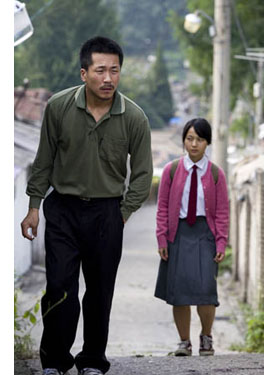 Also under the influence of classic crime films was Yang Ik-June’s Breathless from Korea (right). It shows a brutal debt collector coming to terms with his childhood. Under a harsh surface realism, the film has the contours of the familiar redemption of a hard case, including the decision to reform that comes a tad too late. (Whenever a crook vows that this will be the last time he pulls a job, wait for the ironic retribution.) I thought that the character parallels (two scenes of murdered mothers) were somewhat too neat, but the director plays the anti-hero with conviction and deadpan humor, and Kim Kkobbi supplies an exhilarating turn as the tough high-school girl who becomes his companion.
Also under the influence of classic crime films was Yang Ik-June’s Breathless from Korea (right). It shows a brutal debt collector coming to terms with his childhood. Under a harsh surface realism, the film has the contours of the familiar redemption of a hard case, including the decision to reform that comes a tad too late. (Whenever a crook vows that this will be the last time he pulls a job, wait for the ironic retribution.) I thought that the character parallels (two scenes of murdered mothers) were somewhat too neat, but the director plays the anti-hero with conviction and deadpan humor, and Kim Kkobbi supplies an exhilarating turn as the tough high-school girl who becomes his companion.
Bong Joon-ho has been something of a leitmotif on this site lately, with my comments on Influenza and Mother. Under the rubric “Bong Joon-Ho & Co.,” Dragons and Tigers screened a collection of shorts paying tribute to the Korean Academy of Film Arts. Most were from the 2000s, but Kim Eui-suk’s Chang-soo Gets the Job, dated from 1984. Focusing on a gang of teenage purse snatchers, Kim’s film was a little rough technically, but it built its story deftly. The quality of the rest was quite strong, with the grisly and wacky Anatomy Class (2000, Zung So-yun) being a high point. Meanwhile, Bong’s Incoherence (1994) shows that his urge to deflate official hypocrisy, seen in Memories of Murder and The Host, was already present in his student days.
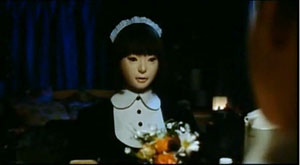
My admiration for Hirokazu Kore-eda runs high, as I indicated in my discussion of Still Walking at last year’s VIFF. But Air Doll, while full of vagrant pleasures, left me unsatisfied. The Kafkaesque premise, derived from a manga, is that an inflatable saucy-French-maid dolly comes to life, endowed with speech and movement but retaining her seams and air valve (both of which will figure in the plot). Her sad-sack owner doesn’t notice the transformation, but while he’s at work, she takes a job at a video store and wanders the city.
The aim, I think, is to defamiliarize ordinary city life by seeing it through Nazomi’s eyes. The fact that a sex effigy is the most innocent character in the movie is part of the point. Makeup, money, and fashion start to seem extensions of sad, solitary eroticism, and the line between mainstream movies and porn gets blurred. But all the thematic elements didn’t blend very well, and at moments, as during the music montages showing people’s desperate loneliness, I worried that for once Kore-eda had slipped into conventional sentimentality. The tone also shifts, with a climax that revises the big scene of In the Realm of the Senses. Kore-eda deserves credit for his unflagging effort to try something fresh with every project, but here, it seemed to me, that the film was defeated by an overcute conceit and underdeveloped execution.
The most exciting Asian film I saw at VIFF was Liu Jiayin’s Oxhide II. Her first feature, Oxhide, was screened at Vancouver in 2005. (Full disclosure: I was on the jury that awarded that film the D & T prize.) This one seemed to me even better.
To say that this 132-minute film is about a family making dumplings is accurate but misleading. To add that the action consumes only nine shots makes it sound like an arid exercise. In fact, it’s a consistently warm, engaging—I don’t hesitate to say entertaining—film that is also a demonstration of how a simple form, patiently pursued, can yield unpredictable rewards.
In the first Oxhide, we saw the comedy and tensions of Liu’s life with her parents, who run a leatherwork shop. By the time she shot part two, they had already lost their business, but the sequel presupposes that the shop is still going, albeit coming to a critical point. So there’s a quasi-documentary aspect, as the family’s financial strains, discussed cryptically at various points, hover over the mundane process of wonton cookery. Yet although everything looks spontaneous, it was all completely staged—written out in detail, rehearsed over months, reworked in test footage, and eventually played out in “real time.”
And in real space. The first shot, which consumes twenty minutes, shows Liu’s father pummeling a hide in his vise and eventually clearing the table for serious food preparation.
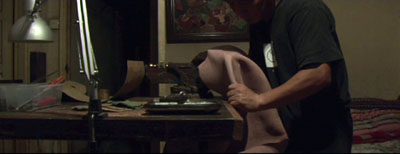
Actually, the film’s subject is that table. On its surface, a meal is prepared; around it, the family gathers; we even see what happens underneath. We watch father and mother chop scallions, mince pork, twist and yank dough, pinch the dumpling wrappers around the filling. We watch the daughter try to match her parents’ dexterity. This is a movie about housework as handiwork, and family routines and frictions.
For minutes on end, we see only hands and arms; Liu’s 2.35 frame often chops off faces. Liu employed a construction-paper mask to create the CinemaScope format within HD video. Why the wide frame? Most filmmakers use it for expansive spectacle, she remarks; but “I wanted to see less.” And the horizontal stretch further emphasizes the table.
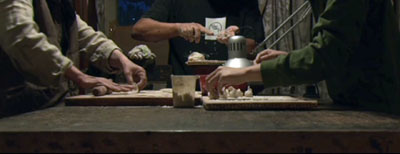
As if this weren’t rigorous enough, Liu has filmed the table from a strictly patterned arc of camera positions, dividing the space into 45-degree segments. These unfold in a clockwise sequence around the table. What could seem an arbitrary structural gimmick is justified by the fact that each setup proves ideally suited to each stage of the process. When father and mother team up to start the meal, the angle gives us two centers of interest. And Liu feels free to “spoil” her mathematical structure by varying the height and angle of her camera. Plates, bowls, and an articulated lamp become massive outcroppings in this micro-landscape.
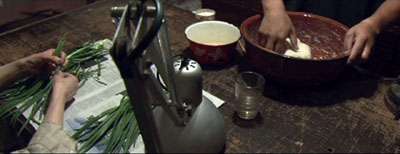
Oxhide II is unpretentiously inventive, quietly virtuosic. Evidently it took a Chinese filmmaker (whose day job is writing TV dramas) to blend domestic life with the rigor of Structural Film. Liu displays the fine-grained resources yielded by several cinema techniques, from framing and staging to lighting and sound. The finished dumplings get constantly rearranged on the cutting board. Each family member has a different technique for pulling off bits of dough, and each gesture yields its own distinctive snap.
I had to think, almost with pity, of all those US indie filmmakers who believe they have to cultivate CGI and slacker acting, to seduce investors and strain for outrageous sex and edgy violence. Liu made this no-budget, low-key masterpiece over years in a single room, and with her parents. That’s a new definition of cool.
Liu promises us another installment. In the meantime, every festival that’s serious about the art of cinema should pledge to show Oxhide II.
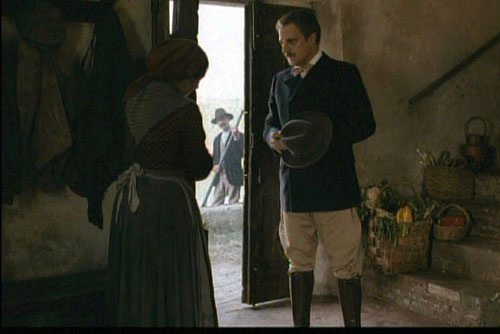
Puccini and the Girl.
PS 12 October: Thanks to Matthew Flanagan for correcting an embarrassing typo.
PS 15 October: Thanks to Ben Slater for correcting yet another one!












